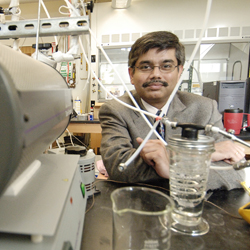Green Manufacturing Lab wins Technology Investigation Award
Money could nudge fuel cells to market

In a few years, Americans could start driving cars that don’t belch nitrogen oxide, hydrocarbons, carbon monoxide, and other pollutants. Instead of fossil-fuel burning internal-combustion engines, fuel cells would sit under the hoods, and they would produce electricity with only heat and water as byproducts. The fuel cells themselves are ready, says Srikanth Gopalan, a College of Engineering assistant professor of manufacturing engineering and head of the Green Manufacturing Lab, whose research focuses on environmentally benign power generation technologies.
What’s lacking is the high-purity hydrogen the cells need to make electricity.
That’s why devising a cheaper and more efficient way to produce pure hydrogen is one of the main focuses of Gopalan’s lab. For two years, he has been working to that end under a Department of Energy program, seeking to make large amounts of hydrogen that is free of impurities such as carbon monoxide, particulates, and sulfur. On February 27, in a boost that may help speed Gopalan’s research to market, his lab received a $25,000 Technology Investigation Award, one of five given out by the Massachusetts Technology Transfer Center (MTTC).
The money will help Gopalan and his corporate partners, CTP Hydrogen of Westborough and Air Products and Chemicals, Inc., of Allentown, Pa., perfect their patent-pending hydrogen production process, in which a dense ceramic membrane conducts the oxygen out of high-temperature steam, leaving a stream of pure hydrogen.
“What we have now are lab prototypes,” says Gopalan. “We’re looking to demonstrate a beta-scale system, which is something between the lab and actual scale, within a year.”
A fuel cell consists of two electrodes of opposite charges sandwiched around an electrolyte catalyst. Hydrogen is fed to one electrode while oxygen is fed to another. The catalyst separates the hydrogen into electrons, which flow through an external circuit (electricity), and protons, which migrate to the oxygen and produce water and heat. (Click here for an animated explanation of fuel cells from the Department of Energy.)
Gopalan’s hydrogen production system is geared toward what are known as proton-exchange membrane (PEM) fuel cells, which operate at a relatively low temperature (80 to 100 degrees Celsius) and for that reason are the most likely candidates for powering cars and other vehicles in the future. His lab is also researching solid oxide fuel cells, which are powerful, but because they reach temperatures as high as 1,000 degrees Celsius, are probably not the best option for a car’s engine block. Solid oxide cells, says Gopalan, are better suited for powering houses and buildings.
Almost everywhere power is needed, fuel cells appear to be on the cusp of becoming a commercial reality. Gopalan estimates that one of the major car manufacturers may introduce a commercial fuel-cell car in about five years. Last year, MTTC held a clean-energy conference where Gopalan presented his work to other researchers and corporate executives. Abi Barrow, director of the MTTC, clearly liked what he saw.
“There’s a huge interest in clean energy,” says Barrow. “People are beginning to see that fuel cells are going to be commercially available, and they need to find ways to supply the hydrogen those fuel cells will need.”
For Gopalan, the market pressures for fuel-cell development coincide with environmental imperatives.
“The energy crisis in a global sense is becoming worse with every passing day,” he says. “We need a way to utilize our fossil energy resources more efficiently and reduce emissions.”